Effect of Natural Weathering on the Mechanical Strength of Bamboo Bio-Concrete
Abstract
1. Introduction
2. Materials and Methods
2.1. Materials
2.2. Bamboo Bio-Concrete (BBC) Production and Surface Treatment
2.3. Natural Durability Test Location and Weather Analysis
2.4. Testing Methods
2.4.1. Visual Surface Analysis
2.4.2. Scanning Electron Microscopy
2.4.3. Uniaxial Compressive Test
3. Experimental Results
- BBC-Control: BBC control, analyzed after curing for 28 days (21 ± 2 °C; RH 55 ± 5%).
- BBC-WR: BBC without external resin, analyzed after 9 and 12 months of weathering.
- BBC-ER: BBC with external resin, analyzed after 9 and 12 months of outdoor weathering.
3.1. Weather Variations
3.2. Workability
3.3. Visual Surface Analysis
3.4. Scanning Electron Microscopy (SEM)
3.5. Uniaxial Compressive Strength
4. Conclusions
- (i)
- The variations in weather conditions showed constant changes in temperature and relative humidity, with changing cycles of precipitation, which caused the surface of the bio-concrete to be cleaned.
- (ii)
- Outdoor weathering caused visual changes on the surface of BBC, a progressive change in color and the faded appearance of the bamboo particles. The changes were just superficial, and after removing a laminate from the surface, the appearance and color returned to the appearance before aging.
- (iii)
- The results from compressive strength tests showed that the stress and modulus of elasticity decreased significantly after external weathering for all the bio-concretes. The most significant decreases were observed in the BBC without external resin (WR) compared to bio-concrete with resin (ER).
- (iv)
- In the BBC-WR samples, after nine months of weathering, decreases in stress (up to 54%) and modulus of elasticity (up to 69%) were observed. After twelve months, more significant reductions of 60% (stress) and 73% (E) were registered. For BBC-ER, the decreases in stress and modulus of elasticity after twelve months of weathering were 52% and 46%, respectively.
- (v)
- The external resin preserved more of the mechanical strength of the bio-concrete but did not prevent visual changes (appearance and color) from being completely preserved. This statement could be verified by microscopic analyses since the integrity of matrix and interface with fibers was relatively well preserved.
- (vi)
- In general, BBC-ER performed better than BBC-WR since internal integrity was more preserved due to the surface treatment, and besides the transition zone of fibers, the cement matrix also showed improvements compared to BBC-WR.
- (vii)
- Bamboo bio-concretes have great potential to be used in construction, depending on the environment. Due to their mechanical characteristics, BBCs can be used as internal partitions, false ceilings, retrofitting or open elements such as hollow brick walls. In the case of external exposure to outdoor weathering, some treatments are necessary, and further studies should be carried out on additional surface protections to recommend their use for external applications.
5. Study Limitations and Future Research
Author Contributions
Funding
Data Availability Statement
Acknowledgments
Conflicts of Interest
References
- Kahawalage, A.C.; Melaaen, M.C.; Tokheim, L.A. Opportunities and challenges of using SRF as an alternative fuel in the cement industry. Clean. Waste Syst. 2023, 4, 100072. [Google Scholar] [CrossRef]
- Andreola, V.M.; Da Gloria, M.H.Y.R.; Pepe, M.; Toledo Filho, R.D. A Comprehensive Experimental Study on the Physical Performance and Durability of Bamboo Bio-Concrete. Sustainability 2024, 16, 5334. [Google Scholar] [CrossRef]
- Arehart, J.H.; Nelson, W.S.; Srubar, W.V., III. On the theoretical carbon storage and carbon sequestration potential of hempcrete. J. Clean. Prod. 2020, 266, 121846. [Google Scholar] [CrossRef]
- Caldas, L.R.; Da Gloria, M.H.Y.R.; Pittau, F.; Andreola, V.M.; Habert, G.; Toledo Filho, R.D. Environmental impact assessment of wood bio-concretes: Evaluation of the influence of different supplementary cementitious materials. Constr. Build. Mater. 2021, 268, 121146. [Google Scholar] [CrossRef]
- Asghari, N.; Memari, A.M. State of the Art Review of Attributes and Mechanical Properties of Hempcrete. Biomass 2024, 4, 65–91. [Google Scholar] [CrossRef]
- Da Gloria, M.Y.R.; Caldas, L.R.; Barros, J.A.O.; Toledo Filho, R.D.A. Comprehensive Approach for Designing Low Carbon Wood Bio-Concretes. Materials 2024, 17, 2742. [Google Scholar] [CrossRef]
- Sangmesh, B.; Patil, N.; Jaiswal, K.K.; Gowrishankar, T.P.; Selvakumar, K.K.; Jyothi, M.S.; Jyothilakshmi, R.; Kumar, S. Development of sustainable alternative materials for the construction of green buildings using agricultural residues: A review. Constr. Build. Mater. 2023, 368, 130457. [Google Scholar]
- Aguiar, A.L.D.; Da Silva, N.; Gomes, B.M.C.; Da Gloria, M.H.Y.R.; Hasparyk, N.P.; Toledo Filho, R.T. Assessment of Wood Bio-Concrete Properties Modified with Silane–Siloxane. Materials 2023, 16, 6105. [Google Scholar] [CrossRef]
- Ahmad, M.R.; Pan, Y.; Chen, B. Physical and mechanical properties of sustainable vegetal concrete exposed to extreme weather conditions. Constr. Build. Mater. 2021, 287, 123024. [Google Scholar] [CrossRef]
- Da Gloria, M.H.Y.R.; Andreola, V.M.; dos Santos, D.O.J.; Pepe, M.; Toledo Filho, R.D. A comprehensive approach for designing workable bio-based cementitious composites. J. Build. Eng. 2021, 34, 101696. [Google Scholar] [CrossRef]
- Arizzi, A.; Viles, H.; Martín-Sanchez, I.; Cultrone, G. Predicting the long-term durability of hemp–lime renders in inland and coastal areas using Mediterranean, Tropical and Semi-arid climatic simulations. Sci. Total Environ. 2016, 542, 757–770. [Google Scholar] [CrossRef] [PubMed]
- Wu, F.; Yu, Q.; Liu, C. Durability of thermal insulating bio-based lightweight concrete: Understanding of heat treatment on bio-aggregates. Constr. Build. Mater. 2021, 269, 121800. [Google Scholar] [CrossRef]
- Ahmad, M.R.; Chen, B.; Haque, M.A.; Shah, S.F.A. Development of a sustainable and innovant hygrothermal bio-composite featuring the enhanced mechanical properties. J. Clean. Prod. 2019, 229, 128–143. [Google Scholar] [CrossRef]
- Souza, P.P.D.; Eires, R.; Malheiro, R. Sugarcane Bagasse as Aggregate in Composites for Building Blocks. Energies 2022, 16, 398. [Google Scholar] [CrossRef]
- Garzón-Barrero, N.M.; Shirakawa, M.A.; Brazolin, S.; de Lara, I.A.R.; Savastano, H., Jr. Evaluation of mold growth on sugarcane bagasse particleboards in natural exposure and in accelerated test. Int. Biodeterior. Biodegrad. 2016, 115, 266–276. [Google Scholar] [CrossRef]
- Aguiar, A.L.D.; Gomes, B.M.C.; Nascimento, M.A.F.R.; Landesmann, A.; Toledo Filho, R.T. Experimental investigation on the fire performance of wood bio-concrete using Cone Calorimeter. Fire Saf. J. 2024, 148, 104225. [Google Scholar] [CrossRef]
- Caldas, L.; Andreola, V.M.; Toledo Filho, R. Avaliação de Indicadores de Ecoeficiência na Produção de Bioconcretos de Bambu. Encontro Nac. Aproveitamento Resíduos Construção 2019, 6, 15–29. [Google Scholar]
- Andreola, V.M.; da Gloria, M.H.Y.R.; Toledo Filho, R.D. Durability of Bamboo Bio-Concretes Exposed to Natural Aging. Constr. Technol. Archit. 2022, 1, 834–841. [Google Scholar]
- Andreola, V.M.; Paiva, R.D.L.M.; Lepine, B.P.; dos Santos, D.O.J.; Proença, K.; Gomes, B.M.C.; Moraes, A.; Quinelato, S.; Hasparyk, N.P.; Toledo Filho, R.T. Biological Durability of Bamboo Bio-Concretes. In International Conference on Bio-Based Building Materials; Springer Nature: Cham, Switzerland, 2023; pp. 716–728. [Google Scholar]
- Shea, A.; Lawrence, M.; Walker, P. Hygrothermal performance of an experimental hemp–lime building. Constr. Build. Mater. 2012, 36, 270–275. [Google Scholar] [CrossRef]
- Horszczaruk, E.; Strzałkowski, J.; Głowacka, A.; Paszkiewicz, O.; Markowska-Szczupak, A. Investigation of Durability Properties for Lightweight Structural Concrete with Hemp Shives Instead of Aggregate. Appl. Sci. 2023, 13, 8447. [Google Scholar] [CrossRef]
- Bambooline. Available online: https://bambooline.com.br/ (accessed on 7 November 2024).
- Tudubambu. Available online: https://tudubambu.com.br/ (accessed on 7 November 2024).
- Zheng, K.; Chen, X. Potential of bamboo-based panels serving as prefabricated construction materials. Eng. Mater. Sci. 2014. [Google Scholar]
- Da Cunha Gomes, B.M.; da Silva, N.A.; Saraiva, A.B.; Caldas, L.R.; Toledo Filho, R.D. Environmental and mechanical performance assessment of bamboo culms and strips for structural use: Evaluation of Phyllostachys pubescens and Dendrocalamus giganteus species. Constr. Build. Mater. 2022, 353, 129078. [Google Scholar] [CrossRef]
- Sheridan, J.; Sonebi, M.; Taylor, S.; Amziane, S. The effect of long term weathering on hemp and rapeseed concrete. Cem. Concr. Res. 2020, 131, 106014. [Google Scholar] [CrossRef]
- Marceau, S.; Gle, P.; Guéguen-Minerbe, M.; Gourlay, E.; Moscardelli, S.; Nour, I.; Amziane, S. Influence of accelerated aging on the properties of hemp concretes. Constr. Build. Mater. 2017, 139, 524–530. [Google Scholar] [CrossRef]
- Walker, R.; Pavia, S.; Mitchell, R. Mechanical properties and durability of hemp-lime concretes. Constr. Build. Mater. 2014, 61, 340–348. [Google Scholar] [CrossRef]
- Viel, M.; Collet, F.; Lecieux, Y.; François, M.L.M.; Colson, V.; Lanos, C.; Lawrence, M. Resistance to mold development assessment of bio-based building materials. Compos. Part B Eng. 2019, 158, 406–418. [Google Scholar] [CrossRef]
- Zukowski, B.; dos Santos, E.R.F.; dos Santos Mendonça, Y.G.; de Andrade Silva, F.; Toledo Filho, R.D. The durability of SHCC with alkali treated curaua fiber exposed to natural weathering. Cem. Concr. Compos. 2018, 94, 116–125. [Google Scholar] [CrossRef]
- Piot, A.; Béjat, T.; Jay, A.; Bessette, L.; Wurtz, E.; Barnes-Davin, L. Study of a hempcrete wall exposed to outdoor climate: Effects of the coating. Constr. Build. Mater. 2017, 139, 540–550. [Google Scholar] [CrossRef]
- Davis, K.; Leavengood, S.; Morrell, J.J. Performance of exterior wood coatings in temperate climates. Coatings 2021, 11, 325. [Google Scholar] [CrossRef]
- Tomak, E.D.; Ustaomer, D.; Ermeydan, M.A.; Yildiz, S. An investigation of surface properties of thermally modified wood during natural weathering for 48 months. Measurement 2018, 127, 187–197. [Google Scholar] [CrossRef]
- Mohebby, B.; Saei, A.M. Effects of geographical directions and climatological parameters on natural weathering of fir wood. Constr. Build. Mater. 2015, 94, 684–690. [Google Scholar] [CrossRef]
- George, B.; Suttie, E.; Merlin, A.; Deglise, X. Photodegradation and photostabilisation of wood–the state of the art. Polym. Degrad. Stab. 2005, 88, 268–274. [Google Scholar] [CrossRef]
- Pandey, K.K.; Vuorinen, T. Comparative study of photodegradation of wood by a UV laser and a xenon light source. Polym. Degrad. Stab. 2008, 93, 2138–2146. [Google Scholar] [CrossRef]
- Sharratt, V.; Hill, C.A.; Kint, D.P. A study of early colour change due to simulated accelerated sunlight exposure in Scots pine (Pinus sylvestris). Polym. Degrad. Stab. 2009, 94, 1589–1594. [Google Scholar] [CrossRef]
- NBR NM 52; Agregado Miúdo–Determinação Da Massa Específica E Massa Específica Aparente. Associação Brasileira de Normas Técnicas: Rio de Janeiro, Brazil, 2009.
- ISO 22157; Bamboo Structures: Determination of Physical and Mechanical Properties of Bamboo Culms: Test Methods. ISO: Geneva, Switzerland, 2019.
- NBR 13276; Argamassa Para Assentamento E Revestimento De Paredes E Tetos—Determinação Do Índice De Consistência. Associação Brasileira de Normas Técnicas: Rio de Janeiro, Brazil, 2016.
- Alvares, C.A.; Stape, J.L.; Sentelhas, P.C.; Gonçalves, J.D.M.; Sparovek, G. Köppen’s climate classification map for Brazil. Meteorol. Z. 2013, 22, 711–728. [Google Scholar] [CrossRef]
- NBR 5739; Concreto—Ensaio De Compressão De Corpos De Prova Cilíndricos. Associação Brasileira de Normas Técnicas: Rio de Janeiro, Brazil, 2018.
- NBR 8522; Concreto—Determinação Dos Módulos Estáticos De Elasticidade E De Deformação À Compressão. Associação Brasileira de Normas Técnicas: Rio de Janeiro, Brazil, 2017.
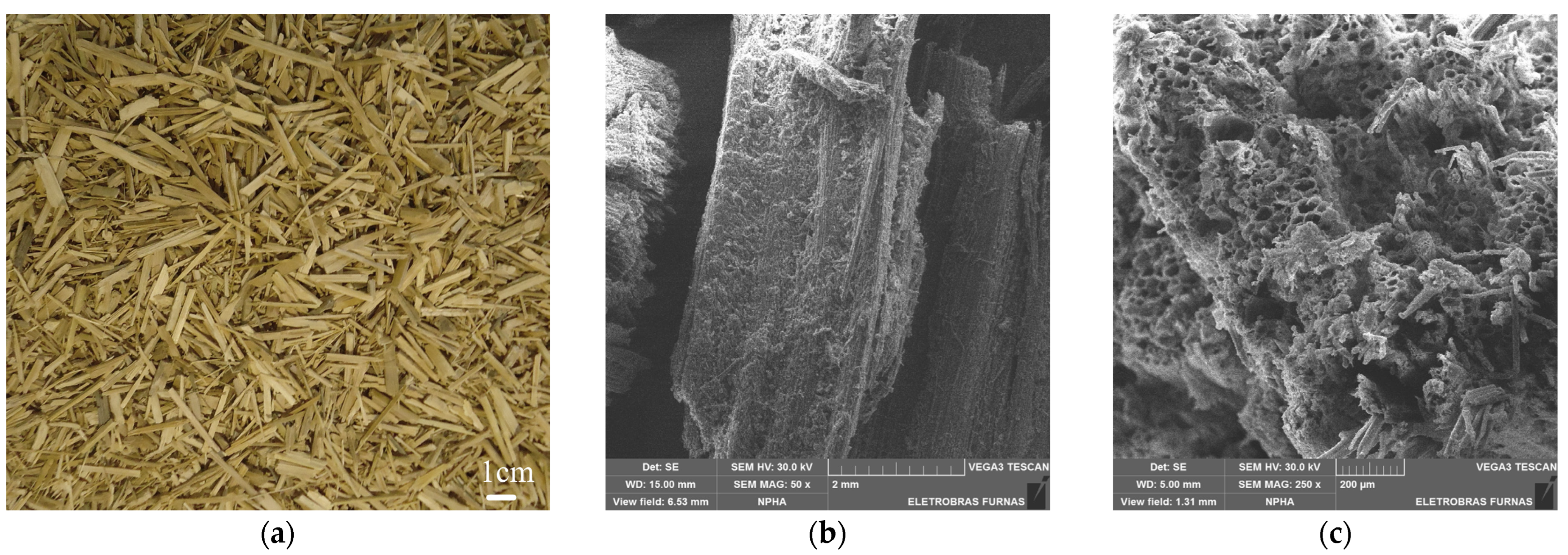
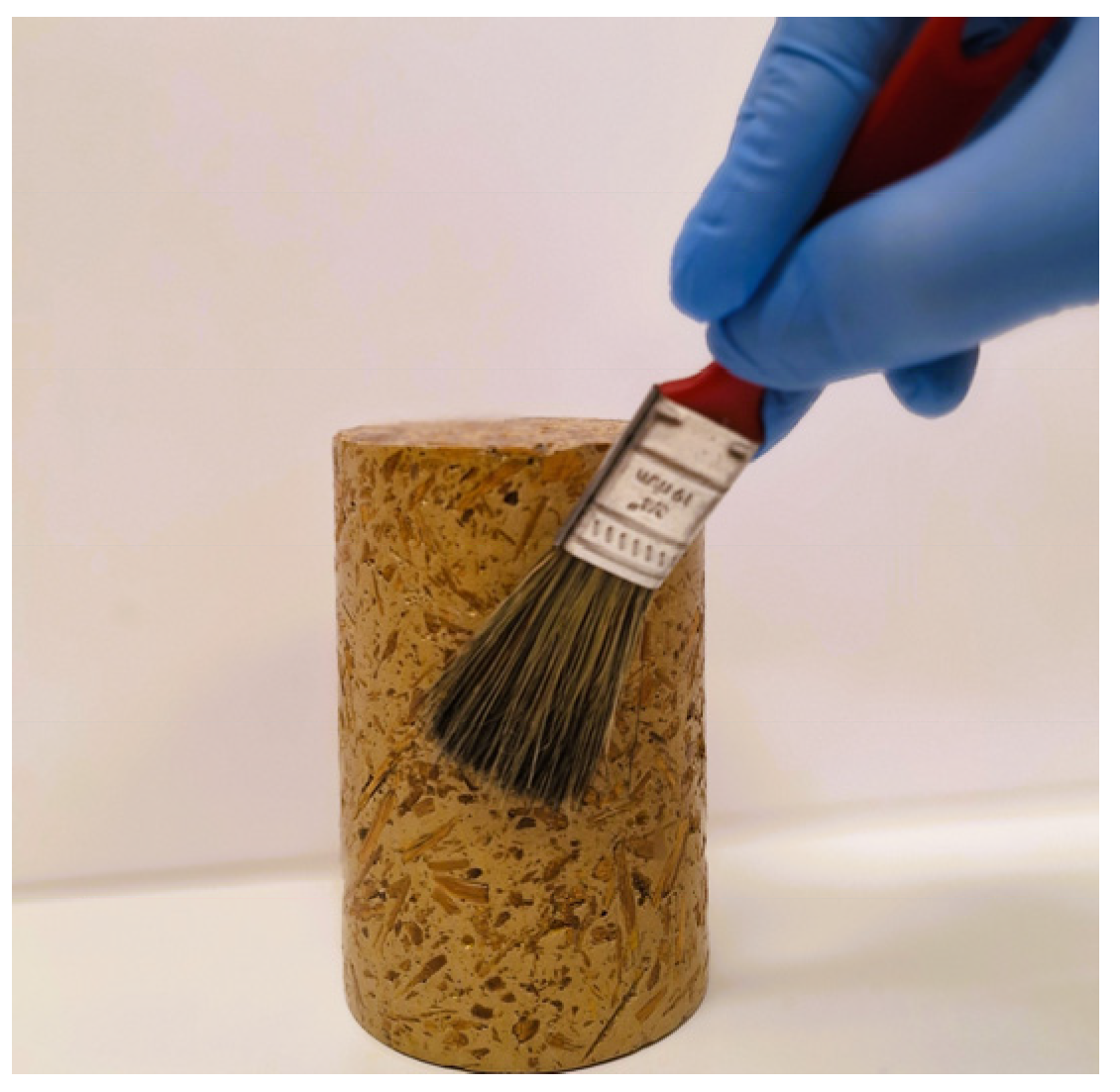
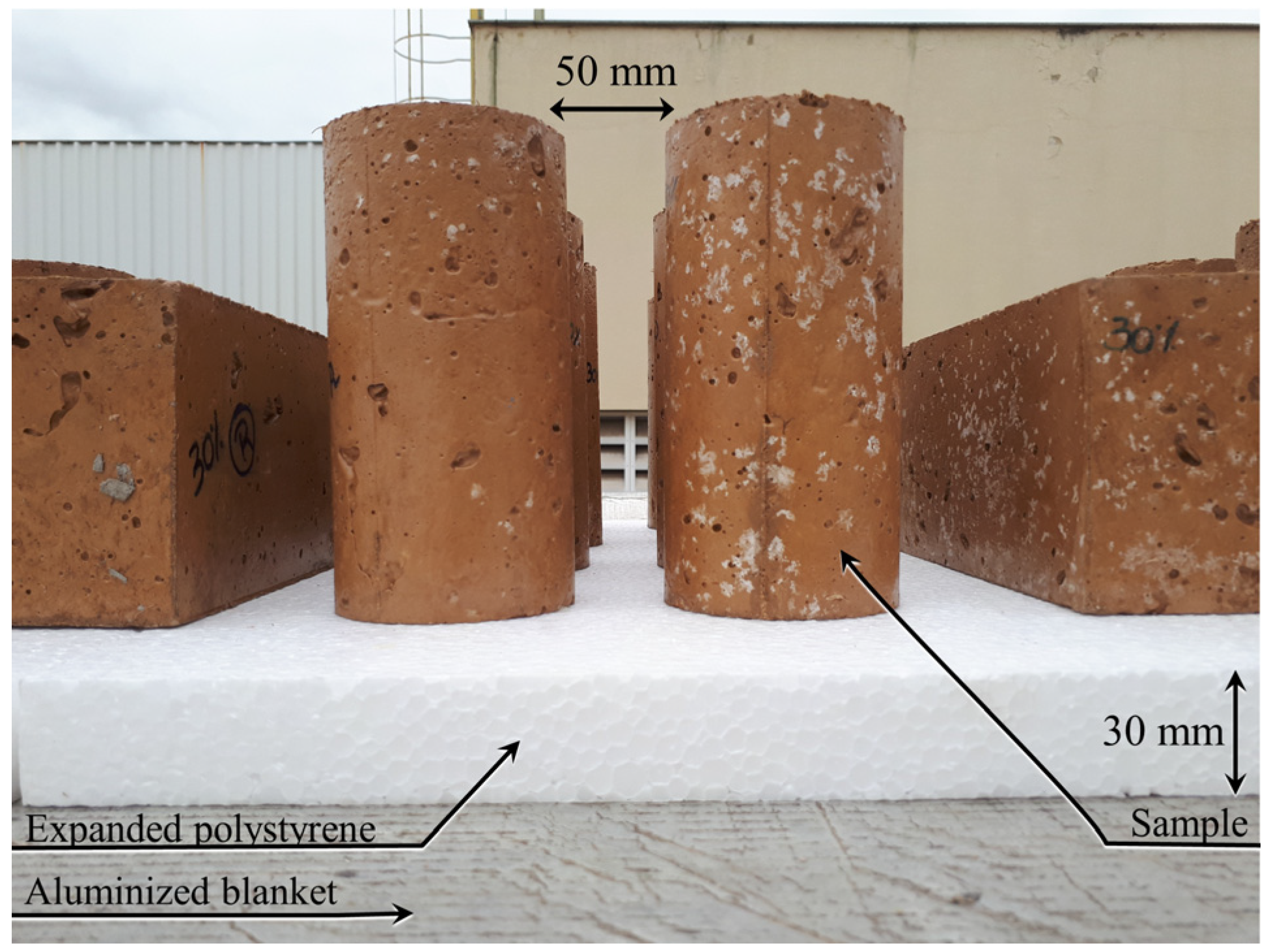
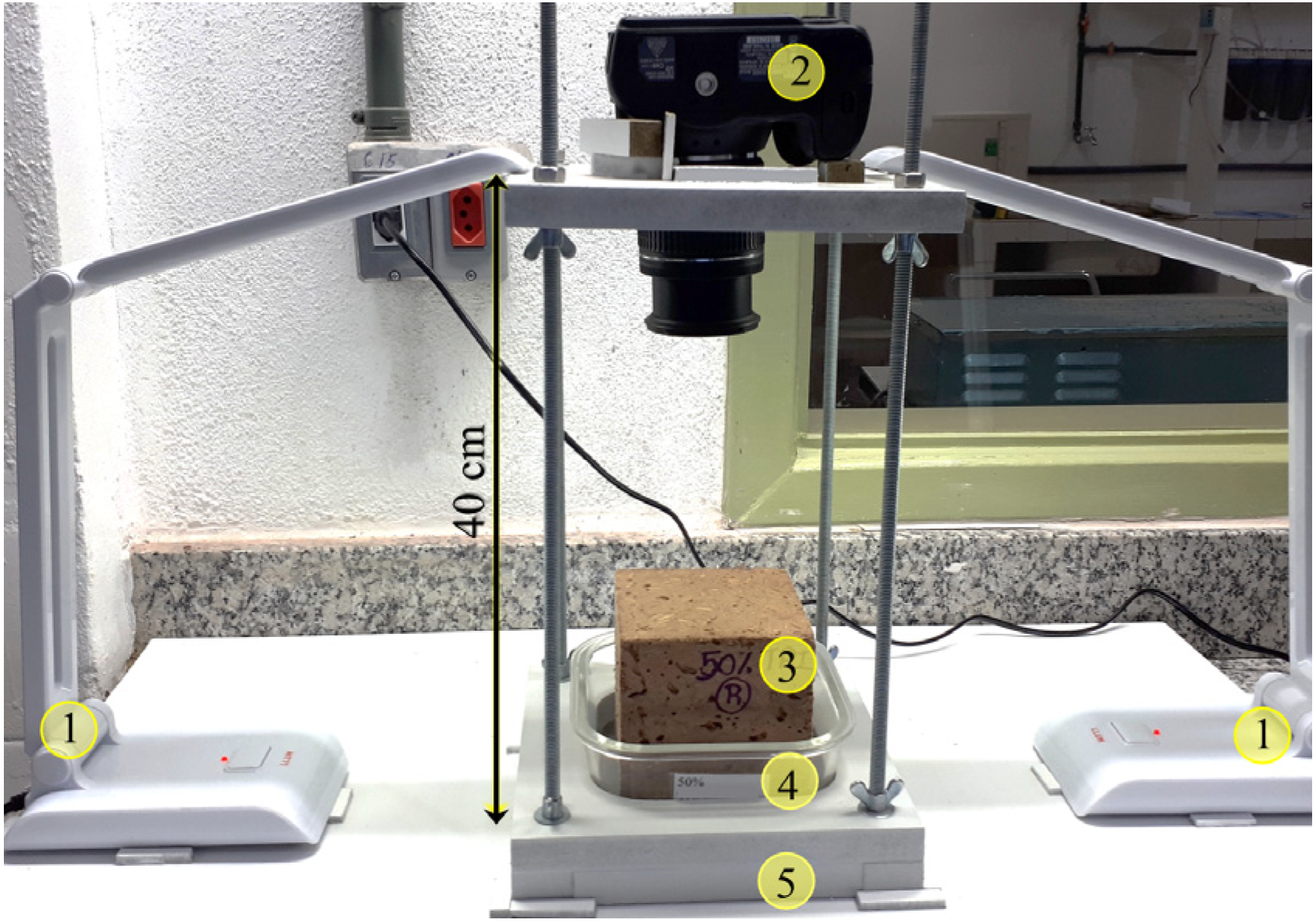
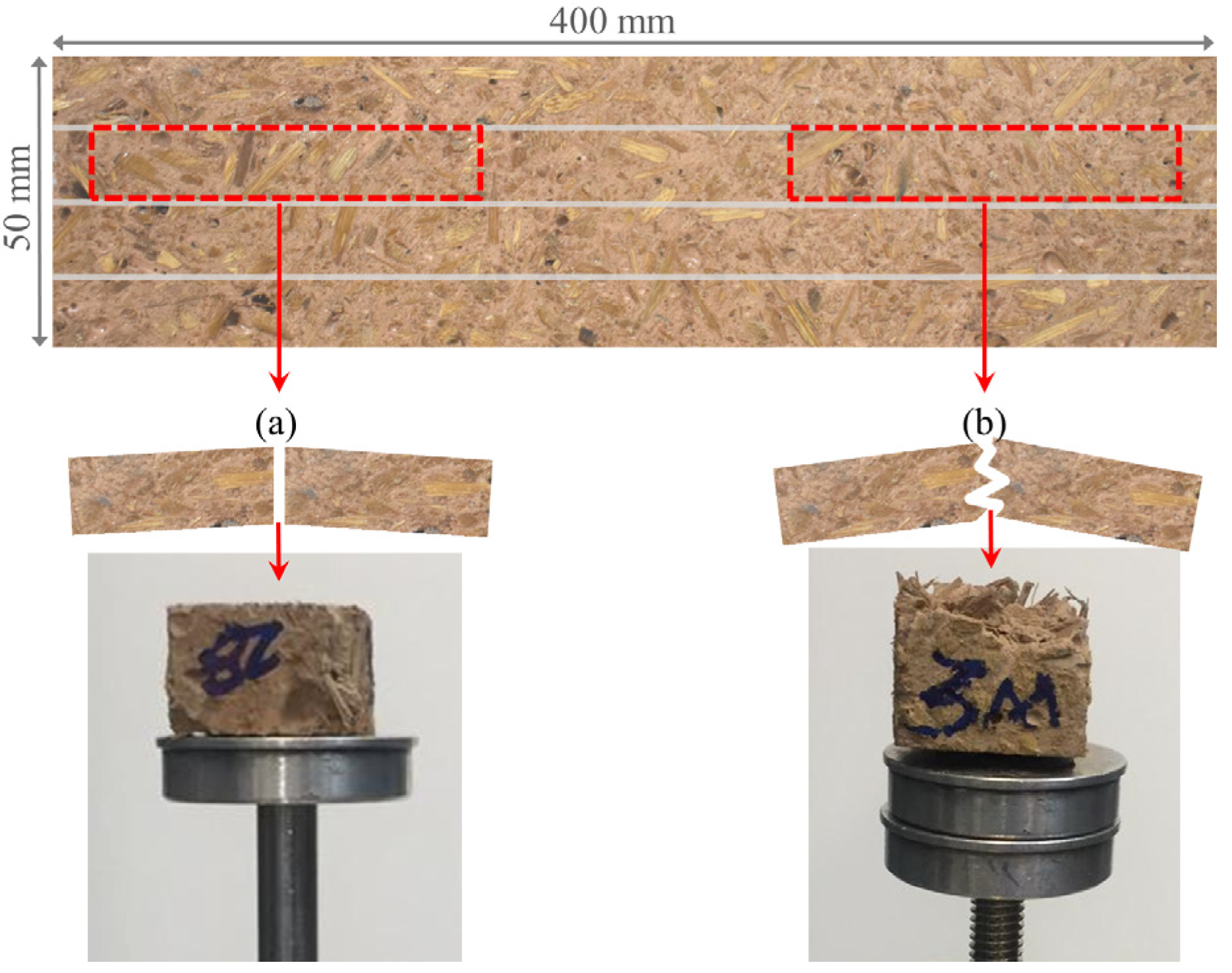




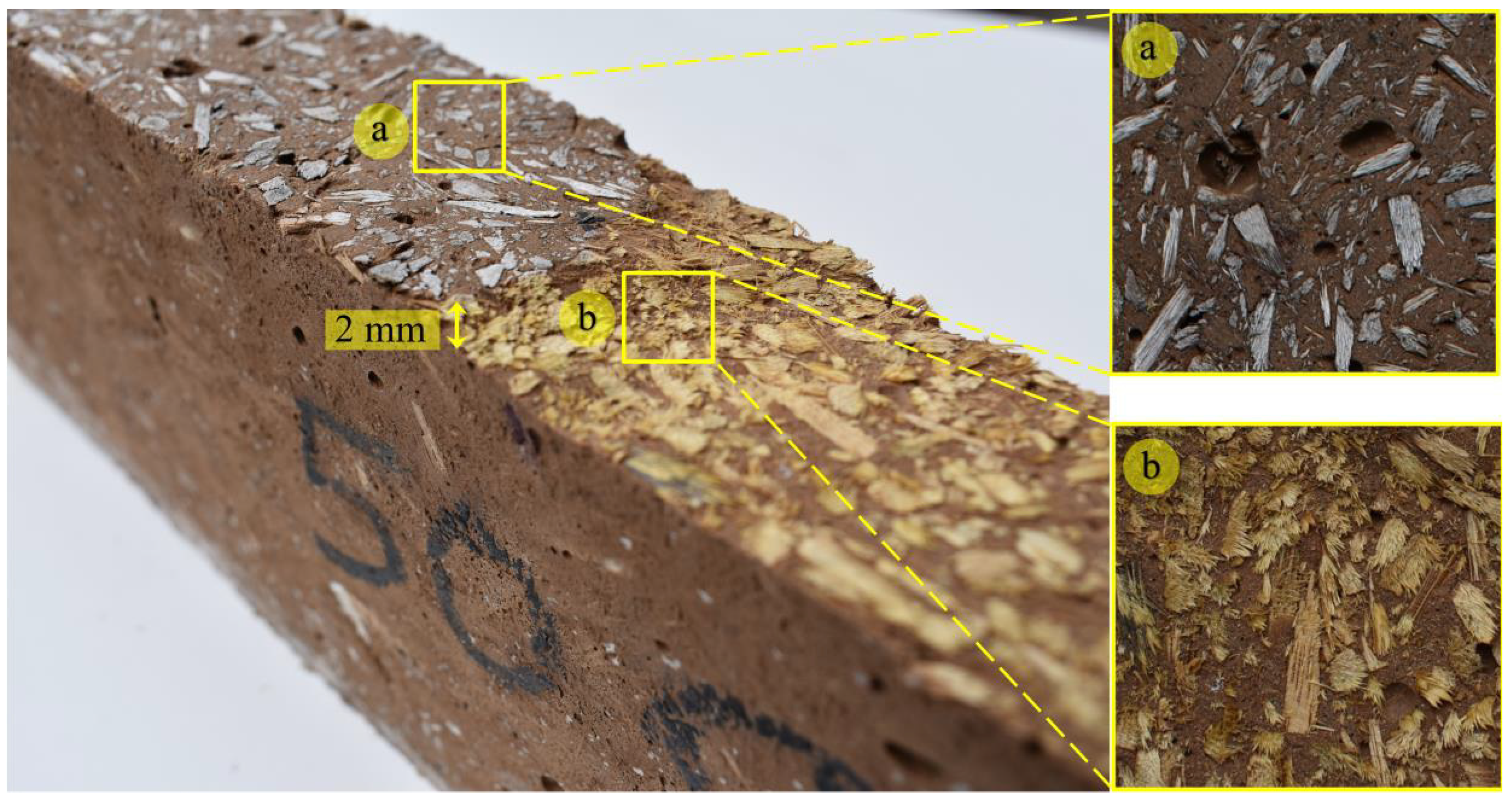
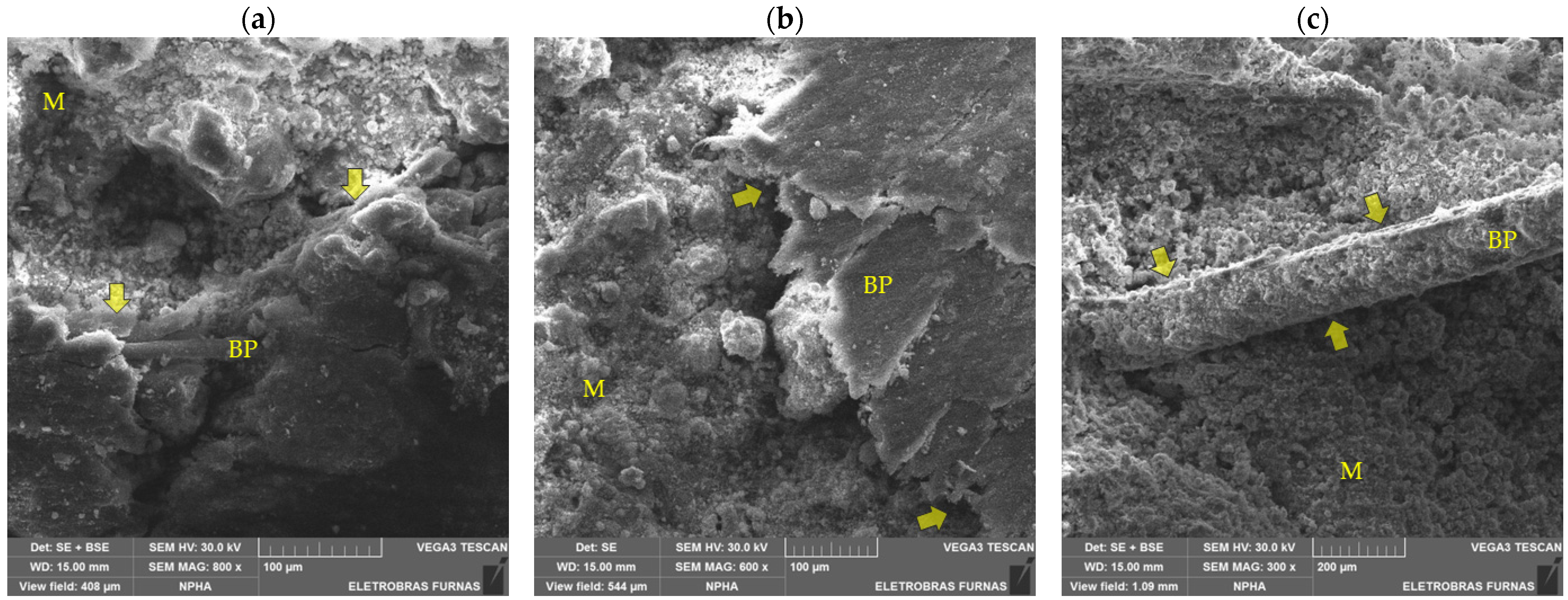
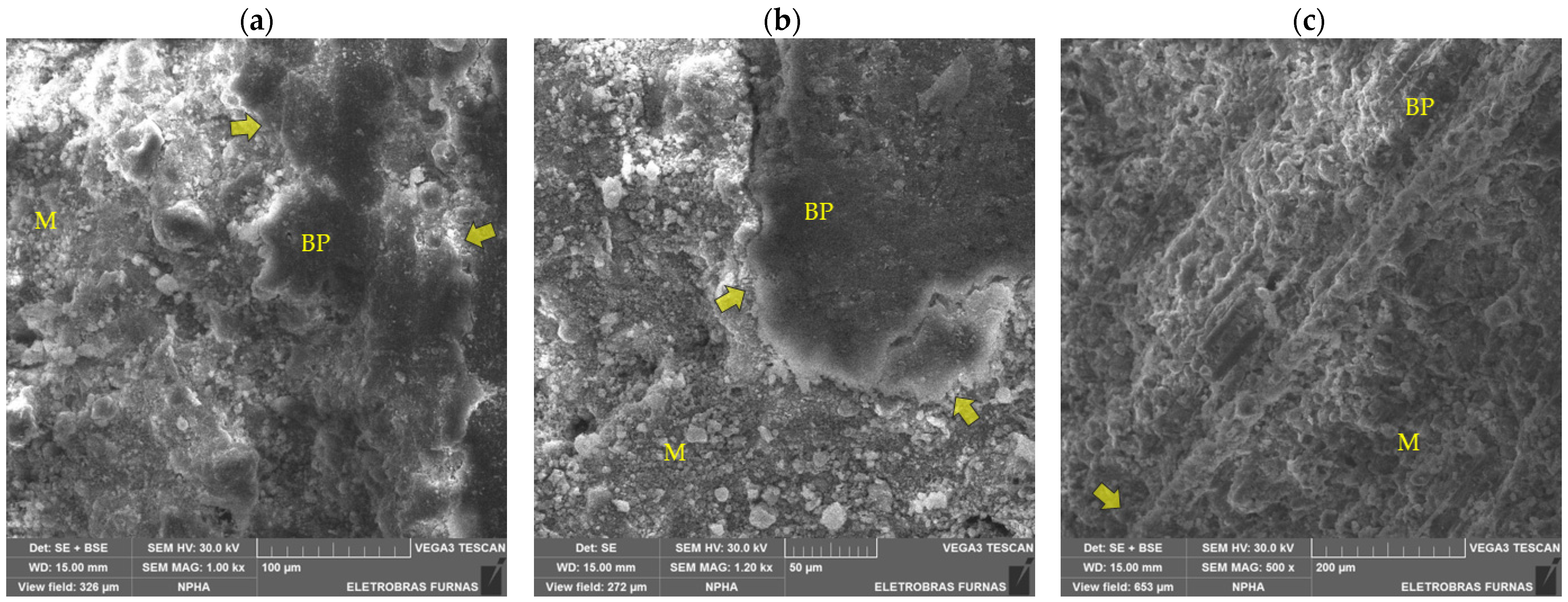
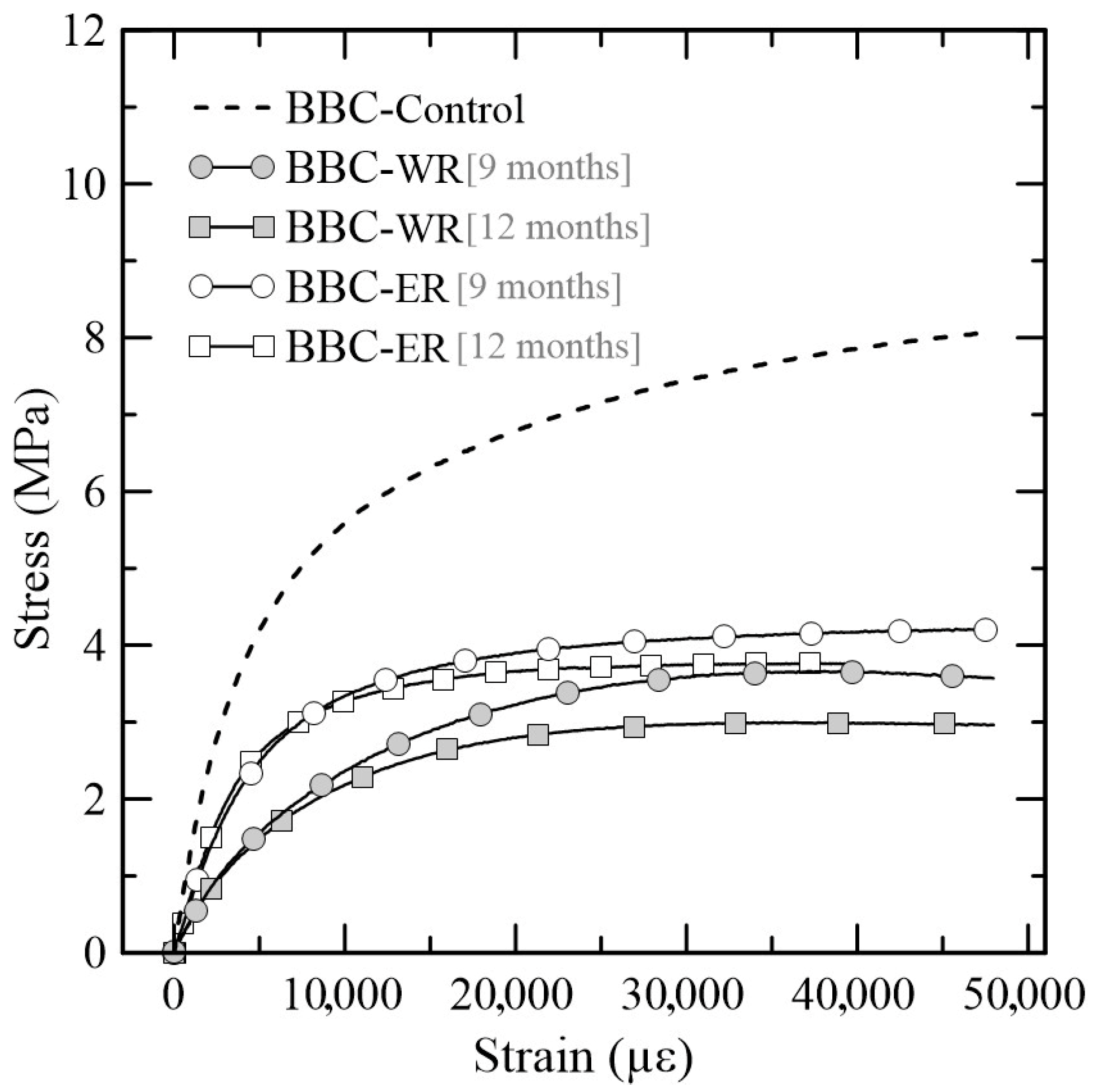
| Chemical Elements (%) | PC | Mk | FA |
|---|---|---|---|
| CaO | 72.63 | - | 2.29 |
| SiO2 | 13.22 | 50.95 | 50.96 |
| Al2O3 | 4.904 | 42.22 | 34.19 |
| Fe2O3 | 3.876 | 1.982 | 5.33 |
| SO3 | 3.355 | 1.202 | 1.59 |
| K2O | 1.075 | 1.983 | 3.52 |
| SrO | 0.484 | 0.004 | 0.024 |
| TiO2 | 0.298 | - | 1.24 |
| MnO | 0.146 | 0.009 | 0.046 |
| Density (kg/m3) | 3053 | 2810 | 1885 |
| BP | PC | Mk | FA | Wh | Wc | CaCl2 | Sp | VMA | |
|---|---|---|---|---|---|---|---|---|---|
| BBC-50 | 295 | 182.1 | 182.1 | 242.7 | 182.11 | 239.27 | 15.93 | 7.96 | 0.79 |
| Compressive Strength (MPa) | Young Modulus (GPa) | |
|---|---|---|
| BBC-Control | 8.06 (2.92) | 1.04 (4.44) |
| BBC-WR/9m | 3.70 (2.99) | 0.32 (1.96) |
| BBC-WR/12m | 3.27 (5.96) | 0.28 (3.71) |
| BBC-ER/9m | 4.40 (1.99) | 0.61 (3.73) |
| BBC-ER/12m | 3.90 (4.32) | 0.56 (4.61) |
Disclaimer/Publisher’s Note: The statements, opinions and data contained in all publications are solely those of the individual author(s) and contributor(s) and not of MDPI and/or the editor(s). MDPI and/or the editor(s) disclaim responsibility for any injury to people or property resulting from any ideas, methods, instructions or products referred to in the content. |
© 2024 by the authors. Licensee MDPI, Basel, Switzerland. This article is an open access article distributed under the terms and conditions of the Creative Commons Attribution (CC BY) license (https://creativecommons.org/licenses/by/4.0/).
Share and Cite
Andreola, V.M.; Hasparyk, N.P.; Toledo Filho, R.D. Effect of Natural Weathering on the Mechanical Strength of Bamboo Bio-Concrete. Buildings 2024, 14, 3629. https://doi.org/10.3390/buildings14113629
Andreola VM, Hasparyk NP, Toledo Filho RD. Effect of Natural Weathering on the Mechanical Strength of Bamboo Bio-Concrete. Buildings. 2024; 14(11):3629. https://doi.org/10.3390/buildings14113629
Chicago/Turabian StyleAndreola, Vanessa Maria, Nicole Pagan Hasparyk, and Romildo Dias Toledo Filho. 2024. "Effect of Natural Weathering on the Mechanical Strength of Bamboo Bio-Concrete" Buildings 14, no. 11: 3629. https://doi.org/10.3390/buildings14113629
APA StyleAndreola, V. M., Hasparyk, N. P., & Toledo Filho, R. D. (2024). Effect of Natural Weathering on the Mechanical Strength of Bamboo Bio-Concrete. Buildings, 14(11), 3629. https://doi.org/10.3390/buildings14113629






